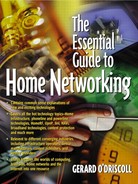WIRELESS LOCAL LOOP
Originally developed to support telephony traffic, the local loop of a telecommunications network now supports a much greater number of subscriber lines transmitting both voice and Internet traffic. The term "local loop" is widely used to describe the electrical circuit between consumers and the local telephone company. The national carriers no longer have exclusive access to the local loop and are facing stiff competition from cable and satellite companies. AT&T, for instance, is spending billions of dollars on upgrading their cable TV networks.
Early in 1999, a new horse entered the race to take control of the local loop— wireless technologies. The battle commenced when two U.S.-based phone giants, MCI WorldCom and Sprint, each started buying up wireless cable companies. This was the beginning of an ambitious campaign to shift away from video programming to high-speed Internet services. Wireless local loop (WLL) is a relatively new service that is used by telecommunications companies to carry IP data from central locations on their networks to small low-cost antennas that are mounted on their subscribers'roofs. Wireless cable Internet access is enabled through the use of a number of distribution technologies, including the multichannel multipoint distribution system (MMDS) and the local multipoint distribution system (LMDS).
MMDS
Analog-based MMDS began in the mid-seventies with the allocation of two television channels for sending business data. This service became very popular, and applications were made to allocate part of the ITFS (Instructional Television Fixed Service) band to wireless cable TV. Once the regulations had been amended it became possible for a wireless cable system to offer up to thirty-one 6-MHz channels in the 2.5 to 2.7 GHz frequency band. During this timeframe, nonprofit organizations used the system to broadcast educational and religious programs. In 1983, the Federal Communications Commission (FCC) allocated frequencies in both of these spectrums, providing 200 MHz bandwidth for licensed network providers. The basic components of a digital MMDS system providing broadband connectivity to a home network are shown in Figure 3.3.
Figure 3.3. MMDS broadband connectivity

An MMDS broadband system consists of a head-end that receives data from a wide variety of sources including Internet Service Providers (ISPs) and TV broadcast stations. At the head-end the data is processed, converted to the 2.1 and 2.7 GHz frequency range and sent to microwave towers. QAM is the most commonly used format used in sending data over an MMDS network, however some operators use a modulation format called Coded Orthogonal Frequency Division Multiplexing (COFDM). This format operates extremely well in conditions likely to be found in heavily built- up areas where digital transmissions become distorted by line of sight obstacles, such as buildings, bridges, and hills. The signals are then rebroadcast from low-powered base stations in a diameter of 35 miles from your home place. Signals are received with home rooftop antennas.
The receiving antenna has a clear line of site to the transmitting antenna. A down converter, usually a part of the antenna, converts the microwave signals into standard cable channel frequencies. From the antenna the signal travels to a gateway device where it is routed and passed onto the various devices that are connected to the in-home network. Today, there are MMDS systems in use all around the United States and in many other countries including Australia, South Africa, South America, Ireland, and Canada.
LMDS
LMDS uses microwave frequencies in the 27 to 31 GHz frequency range to send and receive broadband signals, which are suitable for the transmission of video, voice, and multimedia data. Digital LMDS has been commercially deployed and is being used to deliver video programming and a plethora of Internet- and telephony-based services to consumers. The system architecture for LMDS is similar to the MMDS system. The reception, processing, and broadcasting of data are the same. The signals are then re-broadcast from low-powered base stations in a 4 to 6 mile radius of your home. Signals are received using six square-inch antennas, which can be mounted either inside or outside of your house. As with the MMDS, the signal travels to the gateway device, is formatted, and is passed to one of the consumer or PC devices connected to the home network.
The LMDS frequency allocations in the United States were auctioned off to the highest bidders in 1999. The auctions raised about $45 million—not very much when you consider it gives the winners the ability to compete with the local telephone company, the local cable company, and Internet service providers.
